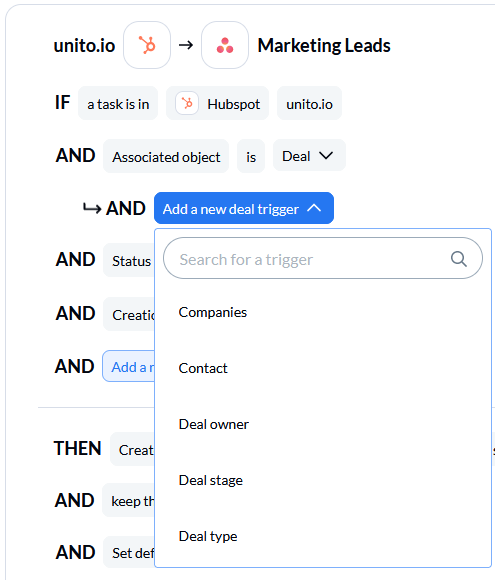- Help Center
- Using Unito
- Advanced Use Cases
-
Get Started With Unito
-
Using Unito
-
Items in Sync, Account Management, and Billing
-
Troubleshooting and FAQs
-
Data Privacy & Security
-
Integration Documentation
- Airtable
- Azure DevOps
- Basecamp
- Bitbucket
- ClickUp
- Confluence
- Eloqua
- Favro
- GitLab
- HubSpot
- Intercom
- Jotform
- Mailchimp
- MeisterTask
- Microsoft Excel
- Microsoft Outlook
- Miro
- monday.com
- Notion
- Pipedrive
- PostgreSQL
- Slack
- Snowflake
- Stripe
- SurveyMonkey
- Teamwork
- Typeform
- Xero
- Zendesk
- Zoho Projects
- MySQL
-
Atlassian Jira Integration Docs
-
Trello Power-Up Docs
-
2-Way ServiceNow Integration
-
Asana Integration Docs
-
Flows, Features and FAQs
-
Google Integration Docs
-
Salesforce Integration Docs
-
Wrike Integration Docs
-
Azure DevOps Integration Docs
-
Smartsheet Integration Docs
-
GitHub Integration Docs
How to Filter Work Items by Associated Object
Filtering rules let you pick which work items sync between tools. For some integrations, you can get even more out of your rules.
Table of contents
-
What’s an associated object?
-
How to filter work items by associated object
-
Things to keep in mind
What’s an “associated object?”
With some integrations, you can get a bit of extra customization out of your rules. Most tools let you filter work items by assignees, labels, and the like. An “associated object” is an extra element you can use in some tools to build filters. For instance, you could set Deals as the associated object in a HubSpot rule, meaning you can build a filter that only syncs tasks associated with Deals.
How to filter work items by associated object
When you set up your flow, you can build rules to determine which work items sync between tools. To add an associated object rule, just add the associated object trigger.

In this example, only HubSpot tasks associated with Deals will be synced over to Asana. It’s that simple!
Things to keep in mind
To make an associated object rule work, you’ll need to do one of two things:
-
Set up a custom field in your other tool: To keep things in sync in a two-way flow, Unito needs a way to track which object a specific work item comes from. For this, you need to set up a custom field in your other tool that supports text. The exact name of the field will vary depending on the tool you’re syncing to.
-
Make a one-way create, two-way update flow: This is our term for flows that only create new items in one direction but keep them updated in both tools. If one of your tools doesn’t support custom fields, you can still build flows with associated object rules. Just make a one-way flow from the tool with custom fields to the tool that doesn’t have them. You can still map your fields for two-way updates, but new work items will only be created in the tool that doesn’t have custom fields.
